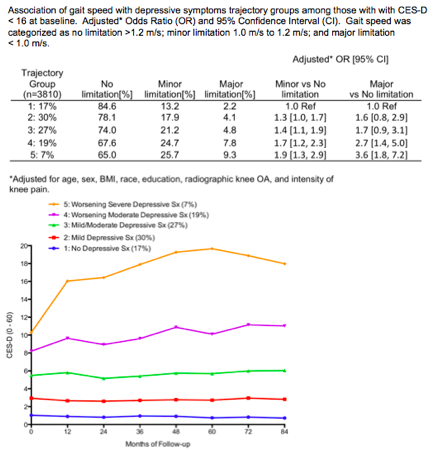Session Information
Date: Wednesday, November 11, 2015
Title: ARHP V: Physical Activity
Session Type: ARHP Concurrent Abstract Session
Session Time: 9:00AM-10:30AM
Background/Purpose: Knee osteoarthritis (OA) is a
well-known risk factor for major depression. While major limitations, e.g., inability
to walk, are thought to mediate this relationship, it is not known to what
extent minor limitations, i.e., not walking at a community speed, may contribute
to depressive symptoms. The purpose
of this study was to investigate the association of minor and major limitations
in walking speed with trajectories of depressive symptoms among people with or
at high risk of knee OA.
Methods: We utilized data from the
Osteoarthritis Initiative (OAI) to describe trajectories of depressive symptoms
over 84-months. Depressive symptoms
were measured annually with the Center for Epidemiologic Studies Depression
Scale (CES-D) which ranges from 0 to 60, with higher
scores representing more depressive symptoms. We included only participants with CES-D
< 16, which represents those without major depression. Gait speed was measured from the
20-meter walk test at baseline. We
categorized ‘No limitation’ as ≥ 1.2 meters/second (m/s) which
represents the minimum time needed to walk across a timed crosswalk, i.e., a community
walking speed; ‘Minor limitation’ as < 1.2 m/s and ≥ 1.0 m/s; and
‘Major limitation’ as < 1.0 m/s which is associated with persistent
functional limitation, hospitalization, and death. To describe trajectories of depressive
symptoms, we used a group-based method (PROC TRAJ) to agnostically identify
homogeneous clusters of developmental trajectories in OAI. We then examined the relation of gait
speed categories with depressive symptom trajectories using multinomial
logistic regression adjusting for age, sex, BMI, race, education, radiographic
knee OA, and intensity of knee pain.
Results: From the 3801 participants included (age
61.4 ± 9.1, BMI 28.4 ± 4.7, 57.5% women, 64% college degree), we identified
five depressive symptom trajectories.
The first three trajectories were stable over time and had baseline
values < 6, on average, and included 74% of the sample. The 4th and 5th
trajectories had worsening scores, increasing 0.4 and 1.0 points/year on the
CES-D and included 19% and 7% of the sample, respectively. Study participants with minor limitation
had 1.7 and 1.9 times the adjusted risk of being in the 4th and 5th
trajectory groups, respectively. Compared
with those without limitation, those with major limitation had 2.7 and 3.6
times the adjusted risk of being in the 4th and 5th
trajectory groups, respectively. (Table)
Conclusion: Loss of the ability to walk a community speed appears to signal
risk for worsening worsening depressive symptoms over time in people with or at
high risk of knee OA. Maintaining walking
speeds adequate to cross the street safely in the community may be important to
consider in order to maintain psychological well-being among people with knee
OA.
To cite this abstract in AMA style:
White D, Neogi T, Zhang Y, Niu J, Katz PP. Does Loss of a Community Walking Speed Lead to More Symptoms of Depression in Knee OA? a Trajectory Analysis from the Osteoarthritis Initiative [abstract]. Arthritis Rheumatol. 2015; 67 (suppl 10). https://acrabstracts.org/abstract/does-loss-of-a-community-walking-speed-lead-to-more-symptoms-of-depression-in-knee-oa-a-trajectory-analysis-from-the-osteoarthritis-initiative/. Accessed .« Back to 2015 ACR/ARHP Annual Meeting
ACR Meeting Abstracts - https://acrabstracts.org/abstract/does-loss-of-a-community-walking-speed-lead-to-more-symptoms-of-depression-in-knee-oa-a-trajectory-analysis-from-the-osteoarthritis-initiative/

